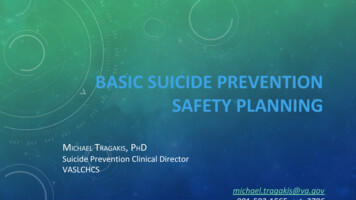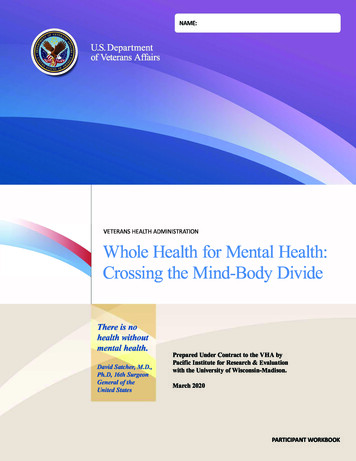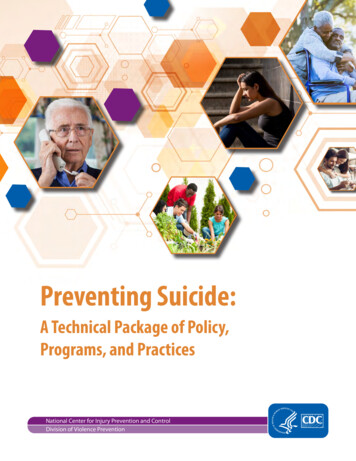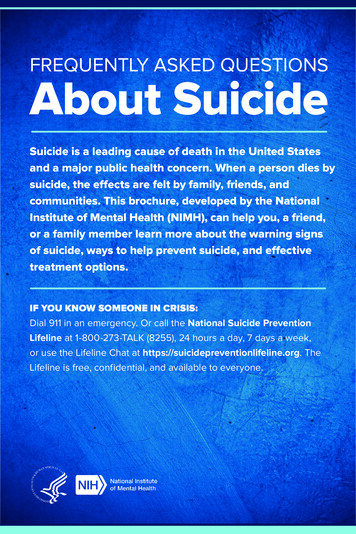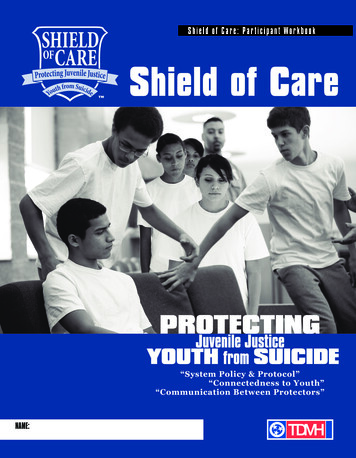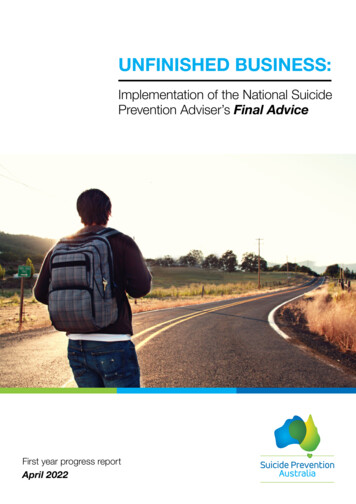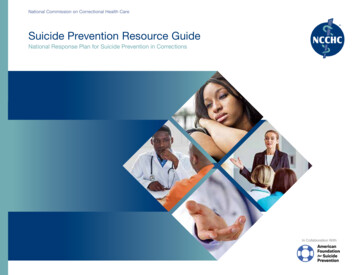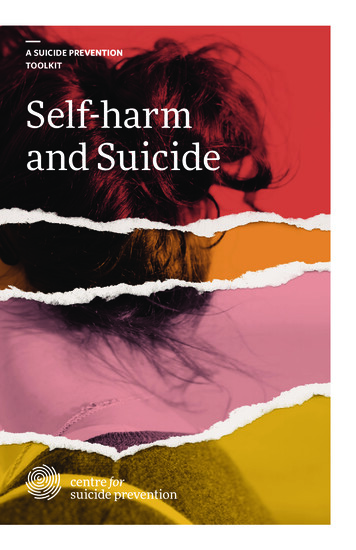
Transcription
A SUICIDE PREVENTIONTOOLKITSelf-harmand Suicide
IN THIS TOOLKITSelf-harm andattempted suicideStatisticsand factsWhy do peopleself-harm?Warning signsTreatmentResourcesReferences
Self-harming behaviours continueto be a major issue in Canada.This is especially true for youngpeople, whose self-harm rates faroutnumber those for adults. Self-harmcan sometimes be associated withincreased suicidality.Self-harm has been defined as“a preoccupation with deliberatelyhurting oneself without conscioussuicidal intent, often resulting indamage to body tissue” (Muehlenkamp,2005, p.324).Self-harm does not include tattooingor piercing, or indirect injury such assubstance abuse or eating disorders(Self-Injury Outreach and Support(SIOS), n.d.).
Self-harm andattempted suicideSelf-harm is also commonly knownas self-injurious behaviour (SIB),self-mutilation, non-suicidalself-injury (NSSI), parasuicide,deliberate self-harm (DSH),self- abuse, and self-inflictedviolence (Klonsky, 2011).As one would expect, having multipleterms for self-harm createsmisunderstanding and confusionboth in academic research andSelf-harm and suicide attempts canalso seem very similar. Sometimesthis can result in incorrect treatmentassessments (Gratz, 2001).Some researchers classify all formsof self-injury on a suicidal continuum(preceding suicidal ideation), regardlessof the victim’s intent. Others emphasizethe marked differences between selfharm and attempted suicide, andbelieve they should be separate areas.in clinical settings.Self-harm and suicide attempts are differentSELF-HARMSUICIDE ATTEMPTSFREQUENCYIncidents arevery frequentAttempts happenless frequentlyMETHODSCutting, burning,self-hittingSelf-poisoningSEVERITYLess severeMuch more severe,sometimes lethalPURPOSEDone to avoidsuicidal impulsesDone with anintent to die(Klonsky, May, & Glenn, 2014)
Self-harm is not suicide, but it may become suicideINJURYAttemptedsuicideSelf-harmLOW INTENTTO DIEHIGH INTENTTO DIEUnintentionalsuicideSuicideDEATH(Centre for Suicide Prevention (CSP), 2016)The majority of those who self-injureBecause self-harm can become suicide,do not have suicidal thoughts whenit is highly recommended that everyself-injuring.patient who self-harms be assessedAlthough self-harm is not the sameas suicide, self-harm can escalate intosuicidal behaviours. The intent to die canchange over time. One study found thatfor suicide risk (SIOS, n.d.).Most common methodsof self-harmalmost half of people who self-harmreported at least one suicide attempt(Klonsky, 2011).Self-harm can also lead tosuicide when: Self-harm is no longer an effective75%CUTTING30%coping method. It ceases to offset thefeelings caused by stress or trauma(Whitlock & Knox, 2007). In a crisis situation, self-harmerswho have become desensitized andhabituated to pain through repeatharming episodes may view a suicideattempt as less frightening(Stewart, 2014).SELF-HITTING28%BURNING(CSP, 2014; Klonsky, 2011)
Statisticsand facts5%OF THE GENERALADULT POPULATIONHAVE SELF-HARMEDAND 15% OF YOUTH.12to15MOST SELF-HARMINGBEGINS BETWEENTHE AGES OFCAUCASIAN PEOPLEHAVE HIGHER RATESGIRLS AGED 14-17OF SELF-HARM THANARE HOSPITALIZEDNON-CAUCASIANS.4xFOR SELF-HARMMORE OFTENTHAN BOYS.2,500YOUTH (AGESFEMALES ADOPT10-17) WERECUTTING MOST OFTEN,HOSPITALIZEDWHILE MALES ARE MOREFOR SELF-HARM INLIKELY TO BURN OR HITCANADA BETWEENTHEMSELVES.2013 AND 2014.(CIHI, 2014; Klonsky, et al., 2011)
Why do peopleself-harm?People are more likely to be atrisk for self-harming behavioursif certain factors are present,such as:People self-harm for a numberof reasons, including:TO FEEL BETTER Self-harm can releasepent-up feelings such as anger andanxiety, or, people who feel numb use loss of a parent; childhood illness or surgery; childhood sexual or physical abuse; family substance abuse;will obviously display their wounds negative body image perceptions;as a way of reaching out for help. lack of impulse control;TO FEEL A SENSE OF CONTROL People childhood trauma; neglect; lack of strong family attachments(Briere & Gil, 1998; CSP, 2014).These risk factors may cause someoneself-harm as a way to feel “something.”TO COMMUNICATE THEIR EMOTIONAL PAINThose who self-harm for this reasonwho self-harm may feel powerlessand lack self-esteem. Self-harm maybe used as a way to regain control. Thisis particularly common for those whohave suffered abuse. There is often apronounced feeling of powerlessness,to adopt self-harm as a learned copingself-loathing, and an absence ofbehaviour to satisfy unmet needs.self-esteem.These behaviours are attempts tocompensate for the lack of healthyfulfillment in their lives (CSP, 2014).TO PUNISH THEMSELVES People whoself-harm may lack self-esteem andthink they are at fault for the waythey feel (CSP, 2014; Klonsky &Muehlenkamp, 2007; Hasking, 2010).
WarningsignsHow can you tell if someoneis self-harming? People whoself-harm may: What to say and what to do if someoneyou know is self-harming: Ask how they are feeling.appear withdrawn, or more Do not be judgmental.quiet or reserved than usual; Be supportive without reinforcingtheir behaviour.stop participating in theirregular activities; Educate yourself about self-harm. have rapid mood changes; Acknowledge their pain. get angry or upset easily; Do not promise confidentiality. have had a significant event Do not avoid the subject.in their lives, e.g. a breakup Do not focus on the behaviour itself. Encourage them to seekwith significant other; suffer poor academic/schoolperformance when they usuallydo very well; exhibit unexplained cutsor scratches; wear clothes that are inappropriatefor the weather, e.g. wearing longsleeves on hot day.(Hasking, 2010; SIOS, n.d.)professional help.(Hasking, 2010; CSP, 2014)
TreatmentsSelf-harm is treatable. Hereare some of the more effectivetreatments:COGNITIVE BEHAVIOUR THERAPY (CBT)is a psychological therapy that aimsto address issues such as anxiety anddepression, as well as a range of othermental health concerns. It helpssomeone become aware of inaccurateor negative thinking, so challengingsituations can be seen more clearlyand responded to more effectively.DIALECTICAL BEHAVIOUR THERAPY (DBT)is a variation of CBT treatment designedfor individuals with self-harmingbehaviours, such as self-cutting,suicidal thoughts, and suicide attempts(Sanderson, 2008). The focus of DBT isto help a person change behavioursthat may be self-destructive – such asself-harm – and work toward a morefulfilling life.PROBLEM SOLVING THERAPY (PST)is a brief psychological interventionthat focuses on identifying the specificproblems that an individual is facingand generating alternative solutionsto these problems. Individuals learnto clearly define a problem that theyface, brainstorm multiple solutions,and decide on the best course ofaction (Hasking, 2010; CIHI, 2014;Sanderson, 2008).
ResourcesS.A.F.E (Self AbuseFinally Ends)AlternativesSelf-Injury Outreachand Support (SIOS)A U.S. based treatment approach,initiative providing information andprofessional network, and educationalresource base which is committedSIOS is a non-profit outreachresources about self-injury to thosewho self-injure, those who haveto helping to achieve an end torecovered, and those who want to help.self-injurious behaviours.SIOUTREACH.ORGSELFINJURY.COM
REFERENCESBriere, J. & Gil, E. (1998). Self-mutilationKlonsky, E., et al. (2011). Nonsuicidalin clinical and general populationself-injury. Toronto, ON. : Hogrefesamples: Prevalence, correlatesPublishing.and functions. American Journalof Orthopsychiatry, 68(4), 609-620.Klonsky, E., May, A., & Glenn, C. (2014).The relationship between nonsuicidalCanadian Institute for Health Information.self-injury and attempted suicide:(2014). Intentional self-harm amongConverging evidence from four samples.youth in Canada. Retrieved fromJournal of Abnormal Psychology, .info child harm en.pdfMuehlenkamp, J. (2005). Self-injuriousCentre for Suicide Prevention. (2016).behavior as a separate clinical syndrome.Straight Talk: Youth Suicide PreventionAmerican Journal of Orthopsychiatry,Workshop. Calgary, AB.: Author.75(2), 324-333.Centre for Suicide Prevention. (2014).Sanderson, C. (2008). Dialectical BehaviorThe 5 things we wish all teachers knewTherapy frequently asked questions.about: Self-harm and suicide. RetrievedRetrieved from http://behavioraltech.org/from aq Cons.pdf64xyc0t/?launcher false&fcsContent tru-e&pbMode normalSelf-Injury Outreach and Support.(n.d.).SIOS: A guide for school professionals.Grantz, K. (2001). Measurement ofRetrieved from http://www.insync-group.deliberate self-harm: Preliminary dataca/publications/SiOS Schoolon the Deliberate Self- Harm Inventory.Professionals.pdfJournal of Psychopathology and BehavioralAssessment, 23(4), 253-263.Stewart, S., Baide, P. & Theall-Honey, L.(2014). Examining non-suicidal self-injuryHasking, M., et al. (2010). Seeking solutionsamong -adolescents with mental healthto self-injury: A guide for young people.needs in Ontario, Canada. ArchivesBrisbane, Australia: Centre for Suicideof Suicide Research, 18(4), 392-409.Prevention Studies, The University ofQueensland.Whitlock, J. & Knox, K. (2007). Therelationship between self-injuriousJoiner, T. (2005). Why people die bybehavior and suicide in a young adultsuicide. Cambridge, MA.: Harvardpopulation. JAMA Pediatrics, 161(7), 634-640.University Press.
We are the Centre forSuicide Prevention, a branchof the Canadian MentalHealth Association. For35 years we have beenequipping Canadians withknowledge and skills torespond to people at riskof suicide.We educate for life.Centre for Suicide PreventionT 403 245 3900csp@suicideinfo.casuicideinfo.ca@cspyyc
and lack self-esteem. Self-harm may be used as a way to regain control. This is particularly common for those who have suffered abuse. There is often a pronounced feeling of powerlessness, self-loathing, and an absence of self-esteem. TO PUNISH THEMSELVES People who self-harm may lack self-esteem and think they are at fault for the way
